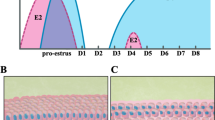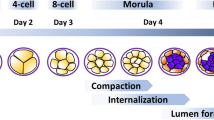Abstract
Pre-eclampsia, one of the major disorders of pregnancy, is characterized by inadequate trophoblast invasion and defective trophoblast-mediated remodeling of placental vasculature. Hypoxia-inducible transcription factor (HIF)-2α plays a critical role in regulating cellular function of trophoblasts; however, its role in placental development and in the pathogenesis of pre-eclampsia remains elusive. CCK-8 assay was used to detect cell viability. Invasion assay was performed to determine the effect of HIF-2α on trophoblast function. Flow cytometry was used for detecting apoptosis and cell cycle. The mRNA and protein expressions of HIF-2α, VEGF, iNOS, and ET-1 were determined by quantitative real-time PCR and western blot techniques. The roles of HIF-2α in JEG-3 trophoblast cells were examined using siRNA technology. The presence of HIF-2α siRNA reduced the levels of cell viability after 48 h incubation, and the cell viability further reduced at 72 h. Besides, HIF-2α siRNA enhanced trophoblast apoptosis, as determined by flow cytometric measurement. Increased G1-phase and decreased S-phase cell population were induced by HIF-2α siRNA based on the determination of cell cycle distribution using propidium iodide staining. Furthermore, the invasive ability of JEG-3 trophoblasts was significantly reduced by HIF-2α siRNA. In addition, knockdown of the HIF-2α gene significantly decreased VEGF, iNOS, and ET-1 levels in JEG-3 human trophoblasts. Our findings provide preliminary evidence of the functions of HIF-2α in trophoblast biology and suggest that the downregulation of HIF-2α enhances cell apoptosis and limits trophoblast invasion.






Similar content being viewed by others
Data Availability
The datasets used and/or analyzed during the current study are available from the corresponding author on reasonable request.
Code Availability
Not applicable.
References
Walker JJ. Pre-eclampsia. Lancet. 2000;356(9237):1260–5. https://doi.org/10.1016/s0140-6736(00)02800-2.
Young BC, Levine RJ, Karumanchi SA. Pathogenesis of preeclampsia. Annu Rev Pathol. 2010;5:173–92. https://doi.org/10.1146/annurev-pathol-121808-102149.
Meade ES, Ma YY, Guller S. Role of hypoxia-inducible transcription factors 1alpha and 2alpha in the regulation of plasminogen activator inhibitor-1 expression in a human trophoblast cell line. Placenta. 2007;28(10):1012–9. https://doi.org/10.1016/j.placenta.2007.04.005.
Jadoon A, Cunningham P, McDermott LC. Regulation of fatty acid binding proteins by hypoxia inducible factors 1α and 2α in the placenta: relevance to pre-eclampsia. Prostaglandins Leukot Essent Fatty Acids. 2015;93:25–9. https://doi.org/10.1016/j.plefa.2014.09.004.
Rajakumar A, Conrad KP. Expression, ontogeny, and regulation of hypoxia-inducible transcription factors in the human placenta. Biol Reprod. 2000;63(2):559–69. https://doi.org/10.1095/biolreprod63.2.559.
Liu W, Wang SJ, Lin QD. Study on the expressions of PHD and HIF in placentas from normal pregnant women and patients with preeclampsia. Int J Biol Sci. 2014;10(3):278–84. https://doi.org/10.7150/ijbs.6375.
Pauli JM, Repke JT. Preeclampsia: short-term and long-term implications. Obstet Gynecol Clin North Am. 2015;42(2):299–313. https://doi.org/10.1016/j.ogc.2015.01.007.
Saito S, Nakashima A. A review of the mechanism for poor placentation in early-onset preeclampsia: the role of autophagy in trophoblast invasion and vascular remodeling. J Reprod Immunol. 2014;101-102:80–8. https://doi.org/10.1016/j.jri.2013.06.002.
Rajakumar A, Whitelock KA, Weissfeld LA, Daftary AR, Markovic N, Conrad KP. Selective overexpression of the hypoxia-inducible transcription factor, HIF-2alpha, in placentas from women with preeclampsia. Biol Reprod. 2001;64(2):499–506. https://doi.org/10.1093/biolreprod/64.2.499.
Zhou Y, Yuge A, Rajah AM, Unek G, Rinaudo PF, Maltepe E. LIMK1 regulates human trophoblast invasion/differentiation and is down-regulated in preeclampsia. Am J Pathol. 2014;184(12):3321–31. https://doi.org/10.1016/j.ajpath.2014.08.013.
Sasagawa T, Nagamatsu T, Morita K, Mimura N, Iriyama T, Fujii T, et al. HIF-2α, but not HIF-1α, mediates hypoxia-induced up-regulation of Flt-1 gene expression in placental trophoblasts. Sci Rep. 2018;8(1):17375. https://doi.org/10.1038/s41598-018-35745-1.
Highet AR, Khoda SM, Buckberry S, Leemaqz S, Bianco-Miotto T, Harrington E, et al. Hypoxia induced HIF-1/HIF-2 activity alters trophoblast transcriptional regulation and promotes invasion. Eur J Cell Biol. 2015;94(12):589–602. https://doi.org/10.1016/j.ejcb.2015.10.004.
Thilaganathan B. Placental syndromes: getting to the heart of the matter. Ultrasound Obstet Gynecol. 2017;49(1):7–9. https://doi.org/10.1002/uog.17378.
Dubinsky V, Poehlmann TG, Suman P, Gentile T, Markert UR, Gutierrez G. Role of regulatory and angiogenic cytokines in invasion of trophoblastic cells. Am J Reprod Immunol. 2010;63(3):193–9. https://doi.org/10.1111/j.1600-0897.2009.00778.x.
Pervin S, Singh R, Hernandez E, Wu G, Chaudhuri G. Nitric oxide in physiologic concentrations targets the translational machinery to increase the proliferation of human breast cancer cells: involvement of mammalian target of rapamycin/eIF4E pathway. Cancer Res. 2007;67(1):289–99. https://doi.org/10.1158/0008-5472.Can-05-4623.
Orucevic A, Bechberger J, Green AM, Shapiro RA, Billiar TR, Lala PK. Nitric-oxide production by murine mammary adenocarcinoma cells promotes tumor-cell invasiveness. Int J Cancer. 1999;81(6):889–96. https://doi.org/10.1002/(sici)1097-0215(19990611)81:6<889::aid-ijc9>3.0.co;2-2.
Kim PK, Zamora R, Petrosko P, Billiar TR. The regulatory role of nitric oxide in apoptosis. Int Immunopharmacol. 2001;1(8):1421–41. https://doi.org/10.1016/s1567-5769(01)00088-1.
Stepovaya YA, Zhavoronok TV, Starikov YV, Bychkov VA, Chasovskih NY, Starikova YG, et al. Regulatory role of nitric oxide in neutrophil apoptosis. Bull Exp Biol Med. 2008;146(6):737–40. https://doi.org/10.1007/s10517-009-0386-5.
Glynn SA, Boersma BJ, Dorsey TH, Yi M, Yfantis HG, Ridnour LA, et al. Increased NOS2 predicts poor survival in estrogen receptor-negative breast cancer patients. J Clin Invest. 2010;120(11):3843–54. https://doi.org/10.1172/jci42059.
Karmakar S, Dhar R, Das C. Inhibition of cytotrophoblastic (JEG-3) cell invasion by interleukin 12 involves an interferon gamma-mediated pathway. J Biol Chem. 2004;279(53):55297–307. https://doi.org/10.1074/jbc.M407013200.
Cervar M, Puerstner P, Kainer F, Desoye G. Endothelin-1 stimulates the proliferation and invasion of first trimester trophoblastic cells in vitro--a possible role in the etiology of pre-eclampsia? J Investig Med. 1996;44(8):447–53.
Jiang YZ, Li Y, Wang K, Dai CF, Huang SA, Chen DB, et al. Distinct roles of HIF1A in endothelial adaptations to physiological and ambient oxygen. Mol Cell Endocrinol. 2014;391(1-2):60–7. https://doi.org/10.1016/j.mce.2014.04.008.
Funding
This study was supported by National Natural Science Foundation of China (grant number 81760276)
Author information
Authors and Affiliations
Contributions
Yingying Xie contributed to the study conception and design. Material preparation, data collection, and analysis were performed by Pengli Luo, Haining Zhao, Meng Ma, Mengting Xu, and Qin Li. The first draft of the manuscript was written by Zhuojia Yang and Cenying He, and all authors commented on previous versions of the manuscript. All authors read and approved the final manuscript.
Corresponding author
Ethics declarations
Ethics Approval
This study contains no human participants or tissues. Ethical approval and informed consent are not applicable for this study.
Conflict of Interest
The authors declare no competing interests.
Additional information
Publisher’s Note
Springer Nature remains neutral with regard to jurisdictional claims in published maps and institutional affiliations.
Rights and permissions
About this article
Cite this article
Xie, Y., Zhao, H., Luo, P. et al. Downregulation of HIF-2α Enhances Apoptosis and Limits Invasion in Human Placental JEG-3 Trophoblast Cells. Reprod. Sci. 28, 2710–2717 (2021). https://doi.org/10.1007/s43032-021-00581-8
Received:
Accepted:
Published:
Issue Date:
DOI: https://doi.org/10.1007/s43032-021-00581-8




